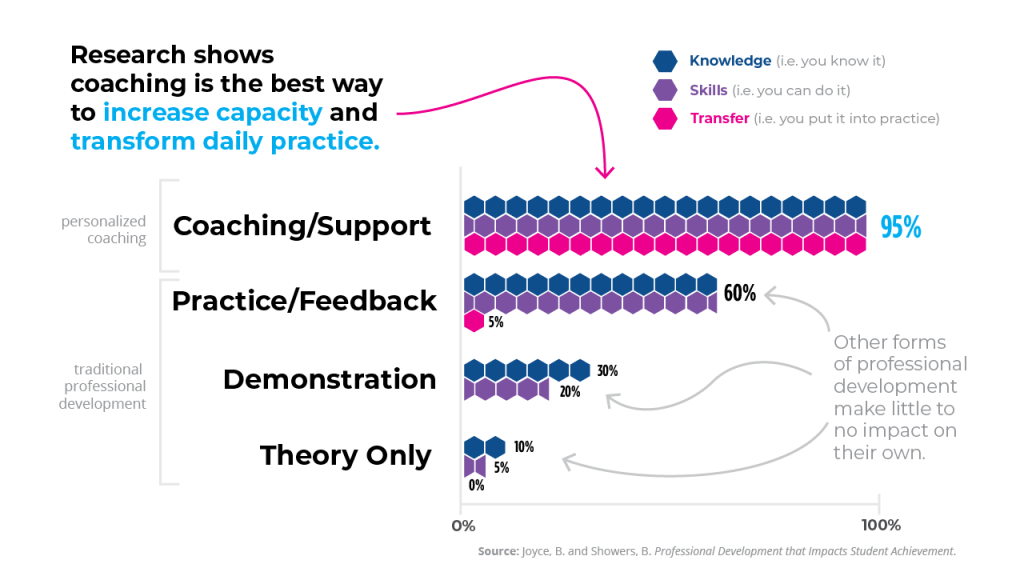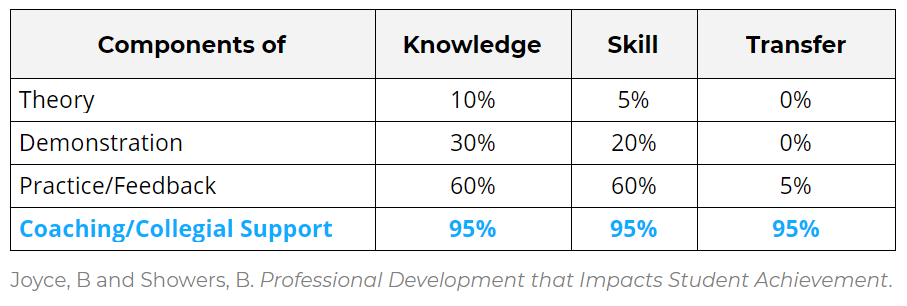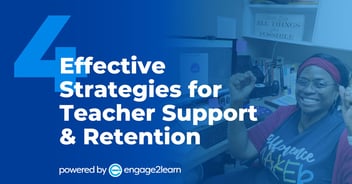The Importance of Being a Data-Informed Leader
Data-Informed… Not Data-Driven
It has always bothered me to hear people talk about being data-driven. Recently, I even heard the term “data-driven culture.” Seriously? Who wants to live in that type of culture? Clearly, data is critical, and we don’t have enough of it. This blog is about why we need more data on coaching, but let’s keep data in the proper perspective. I hope that leaders are using data to inform decisions rather than using data as a driver of decisions and especially not as a driver of culture. As I tell my team, data is a starting point to help you ask the right questions and solve problems that are real. However, data should not be in the driver’s seat. Real leadership means using data, experience, intuition, and context to create elegant solutions and make wise decisions.
Coaching is Catching On!
I am excited that so many districts are implementing coaching. From the very beginning of e2L in 2011, we took the stance that we would not waste taxpayer dollars; therefore, we will turn down business rather than provide training without coaching. Research shows that training without coaching only transfers to implementation at a rate of 5%, but training with coaching transfers to implementation at a rate near 95% (Joyce & Showers, 2002). Additionally, according to The Effect of Teacher Coaching on Instruction and Achievement, recently published by Brown University: “Effects on achievement also are larger than pooled estimates from 27 causal studies of almost all other school-based interventions reviewed by Fryer (2017) including student incentives, teacher pre-service training, merit-based pay, general PD, data-driven instruction, and extended learning time,” (Kraft, Blazar, & Hogan). I am excited that leaders are using this research to make decisions because it means that all dollars (estimated at $8 billion annually) spent on professional learning has a chance to make a difference. That difference can impact learners’ lives and public education as a whole through talent transformation.


Where’s the Data?
Here are the challenges that we have now that so many districts are implementing coaching.
- Is coaching being implemented in a way to get these results?
- Is it being treated like the powerful tool that it is?
- Is it being studied and defined precisely and iterated in order to improve it?
- Is it being documented? Most leaders with whom I visit outside of our partner districts say that they do not have a way to know what is actually happening. I recently saw data on student performance and accountability ratings shared and credited to a particular coaching model without any data having been collected and analyzed on the actual coaching.
- How many conversations led to those increases?
- How many observations?
- What was the content of the coaching process?
- What were the coaching standards?
- Which teachers or leaders grew the most?
- Was the growth from coaching for adults correlated to the increases in scores for learners? If no data is collected or if it collected in separate locations, then nobody really knows.
It is like going on a trip and not taking any pictures. Would we consider taking a trip without documenting it? If you did, it would be fun while it lasted, but there would be no record to remind you of any of it. You might remember the experience, but you wouldn’t have the details, and it would be more challenging to communicate about the trip to others. Or, to apply a metaphor closer to home, would we have students learn lessons for a week without documenting any progress or needs for growth?
Coaching is a good thing, but with so many definitions and so many ways to do it, we need more data to analyze in order to decide what works best. Everyone I talk to has a different definition. Some think of it as just talking, providing resources, or problem-solving. Others are using a model they have read about in a book. Still, others are using it to create “robots” of teachers who can follow scripted strategies. With the money that we are now investing in coaching positions and coaching resources, we need to be sure that investment is done well! We need to document what we are doing, so the value is not limited to the moment. We need to have more data to be able to analyze. We need to be able to define what works so that people can make wise decisions, and we can truly use coaching to build capacity within the education profession that will outlive the latest trends.
Coaching Done Well at Scale
We need to ensure that we are only satisfied with tools and options for coaching that can be replicated at scale. Since we know that the power of coaching is available and right for every person, we need to ensure that the solutions we choose are only those solutions that can be provided within the current context of time and money constraints. For example, the lengthy coaching cycle that includes multiple observations and conferences per strategy for one teacher might be effective, but it is not scalable. Research has proven that this type of coaching cycle is not affordable over time for everyone (source).
As a leader, ask the questions that will ensure you get the results you are promising – from the coaching your stakeholders are supporting through taxpayer dollars. To continue to justify coaching positions, accurate and solid data on the coaching process is critical.
Public schools, catering to a diverse range of students, require comprehensive solutions to navigate the complexities of educational data analysis and instruction. This is where engage2learn's innovative GroweLab platform comes into play, revolutionizing the way schools harness data-informed growth and instruction.
Engage2Learn’s GroweLab: Unleashing the Power of Data
Since 2011, engage2learn has been helping public schools implement smart professional learning that integrates professional growth analytics with student and staff outcomes. engage2learn's GroweLab platform is a comprehensive solution designed to empower educators, administrators, and districts with data-driven insights to enhance instructional practices and drive student growth. It seamlessly combines technology, data analysis, and educational expertise to create a holistic platform that supports educators in their journey toward continuous improvement.
Key Features of GroweLab:
Data Aggregation and Visualization: GroweLab aggregates data from various sources, including student assessments, classroom observations, and feedback. It then presents this data in intuitive visualizations, enabling educators to gain a clear understanding of teacher and student progress, and instructional coaching effectiveness.
Customized Insights: The platform doesn't just provide raw data; it transforms it into actionable insights. By analyzing trends and patterns, educators can identify specific areas where teachers and students excel and areas where they need additional support to provide data-informed instruction.
Goal Setting and Tracking: Educators can set individualized goals for both themselves and their students. The platform's tracking features allow for continuous monitoring of progress toward these goals, enabling timely interventions if needed.
Professional Learning: To foster growth among educators, GroweLab offers personalized education professional development based on data analysis. This ensures that teachers have access to the right resources to address their specific needs.
Collaborative Coaching: The platform facilitates a coaching collaborative for educators, enabling them to share best practices, strategies, and resources based on data-driven insights. This creates a community of support and innovation within the school.
Advantages of GroweLab:
- In-Depth Data Reporting. Instructional coaching powered by easy-to-read education data analytics helps leaders identify skill gaps, celebrate growth, and correlate educator and student growth data to optimize their coaching program and achieve the best outcomes.
- Competency-based professional growth allows your teachers and staff to progress at their own pace and focus on the skills that are most relevant to their needs, keeping them engaged and motivated.
- Personalized Goal Setting & Autonomy. The GroweLab platform empowers teachers to set their own goals based on their experience, expertise, and self-identified areas for growth to foster ownership, relevance and increased engagement in the coaching process.
- Evidence of Practice. Adding evidence of high-level implementation to GroweLab’s digital portfolio allows teachers to document their growth, and coaches to provide feedback and verify implementation of new strategies in the classroom.
- Empowered Educators: By providing educators with the tools they need to interpret and use data effectively, GroweLab empowers them to take ownership of their professional growth and impact on student success.
engage2learn's GroweLab platform offers a powerful solution for public schools to harness the potential of data-informed growth and instruction. By seamlessly integrating data aggregation, analysis, actionable insights, and empowers educators to create impactful learning experiences, leading to improved student outcomes and a brighter future for education.
Interested in learning more about engage2learn’s GroweLab instructional coaching platform for public schools? Let’s talk.



